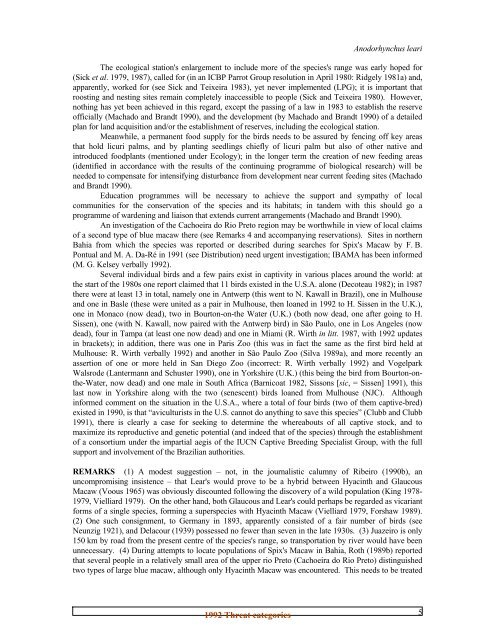Threatened Birds of the Americas - BirdLife International
Threatened Birds of the Americas - BirdLife International
Threatened Birds of the Americas - BirdLife International
You also want an ePaper? Increase the reach of your titles
YUMPU automatically turns print PDFs into web optimized ePapers that Google loves.
Anodorhynchus leari<br />
The ecological station's enlargement to include more <strong>of</strong> <strong>the</strong> species's range was early hoped for<br />
(Sick et al. 1979, 1987), called for (in an ICBP Parrot Group resolution in April 1980: Ridgely 1981a) and,<br />
apparently, worked for (see Sick and Teixeira 1983), yet never implemented (LPG); it is important that<br />
roosting and nesting sites remain completely inaccessible to people (Sick and Teixeira 1980). However,<br />
nothing has yet been achieved in this regard, except <strong>the</strong> passing <strong>of</strong> a law in 1983 to establish <strong>the</strong> reserve<br />
<strong>of</strong>ficially (Machado and Brandt 1990), and <strong>the</strong> development (by Machado and Brandt 1990) <strong>of</strong> a detailed<br />
plan for land acquisition and/or <strong>the</strong> establishment <strong>of</strong> reserves, including <strong>the</strong> ecological station.<br />
Meanwhile, a permanent food supply for <strong>the</strong> birds needs to be assured by fencing <strong>of</strong>f key areas<br />
that hold licuri palms, and by planting seedlings chiefly <strong>of</strong> licuri palm but also <strong>of</strong> o<strong>the</strong>r native and<br />
introduced foodplants (mentioned under Ecology); in <strong>the</strong> longer term <strong>the</strong> creation <strong>of</strong> new feeding areas<br />
(identified in accordance with <strong>the</strong> results <strong>of</strong> <strong>the</strong> continuing programme <strong>of</strong> biological research) will be<br />
needed to compensate for intensifying disturbance from development near current feeding sites (Machado<br />
and Brandt 1990).<br />
Education programmes will be necessary to achieve <strong>the</strong> support and sympathy <strong>of</strong> local<br />
communities for <strong>the</strong> conservation <strong>of</strong> <strong>the</strong> species and its habitats; in tandem with this should go a<br />
programme <strong>of</strong> wardening and liaison that extends current arrangements (Machado and Brandt 1990).<br />
An investigation <strong>of</strong> <strong>the</strong> Cachoeira do Rio Preto region may be worthwhile in view <strong>of</strong> local claims<br />
<strong>of</strong> a second type <strong>of</strong> blue macaw <strong>the</strong>re (see Remarks 4 and accompanying reservations). Sites in nor<strong>the</strong>rn<br />
Bahia from which <strong>the</strong> species was reported or described during searches for Spix's Macaw by F. B.<br />
Pontual and M. A. Da-Ré in 1991 (see Distribution) need urgent investigation; IBAMA has been informed<br />
(M. G. Kelsey verbally 1992).<br />
Several individual birds and a few pairs exist in captivity in various places around <strong>the</strong> world: at<br />
<strong>the</strong> start <strong>of</strong> <strong>the</strong> 1980s one report claimed that 11 birds existed in <strong>the</strong> U.S.A. alone (Decoteau 1982); in 1987<br />
<strong>the</strong>re were at least 13 in total, namely one in Antwerp (this went to N. Kawall in Brazil), one in Mulhouse<br />
and one in Basle (<strong>the</strong>se were united as a pair in Mulhouse, <strong>the</strong>n loaned in 1992 to H. Sissen in <strong>the</strong> U.K.),<br />
one in Monaco (now dead), two in Bourton-on-<strong>the</strong> Water (U.K.) (both now dead, one after going to H.<br />
Sissen), one (with N. Kawall, now paired with <strong>the</strong> Antwerp bird) in São Paulo, one in Los Angeles (now<br />
dead), four in Tampa (at least one now dead) and one in Miami (R. Wirth in litt. 1987, with 1992 updates<br />
in brackets); in addition, <strong>the</strong>re was one in Paris Zoo (this was in fact <strong>the</strong> same as <strong>the</strong> first bird held at<br />
Mulhouse: R. Wirth verbally 1992) and ano<strong>the</strong>r in São Paulo Zoo (Silva 1989a), and more recently an<br />
assertion <strong>of</strong> one or more held in San Diego Zoo (incorrect: R. Wirth verbally 1992) and Vogelpark<br />
Walsrode (Lantermann and Schuster 1990), one in Yorkshire (U.K.) (this being <strong>the</strong> bird from Bourton-on<strong>the</strong>-Water,<br />
now dead) and one male in South Africa (Barnicoat 1982, Sissons [sic, = Sissen] 1991), this<br />
last now in Yorkshire along with <strong>the</strong> two (senescent) birds loaned from Mulhouse (NJC). Although<br />
informed comment on <strong>the</strong> situation in <strong>the</strong> U.S.A., where a total <strong>of</strong> four birds (two <strong>of</strong> <strong>the</strong>m captive-bred)<br />
existed in 1990, is that “aviculturists in <strong>the</strong> U.S. cannot do anything to save this species” (Clubb and Clubb<br />
1991), <strong>the</strong>re is clearly a case for seeking to determine <strong>the</strong> whereabouts <strong>of</strong> all captive stock, and to<br />
maximize its reproductive and genetic potential (and indeed that <strong>of</strong> <strong>the</strong> species) through <strong>the</strong> establishment<br />
<strong>of</strong> a consortium under <strong>the</strong> impartial aegis <strong>of</strong> <strong>the</strong> IUCN Captive Breeding Specialist Group, with <strong>the</strong> full<br />
support and involvement <strong>of</strong> <strong>the</strong> Brazilian authorities.<br />
REMARKS (1) A modest suggestion – not, in <strong>the</strong> journalistic calumny <strong>of</strong> Ribeiro (1990b), an<br />
uncompromising insistence – that Lear's would prove to be a hybrid between Hyacinth and Glaucous<br />
Macaw (Voous 1965) was obviously discounted following <strong>the</strong> discovery <strong>of</strong> a wild population (King 1978-<br />
1979, Vielliard 1979). On <strong>the</strong> o<strong>the</strong>r hand, both Glaucous and Lear's could perhaps be regarded as vicariant<br />
forms <strong>of</strong> a single species, forming a superspecies with Hyacinth Macaw (Vielliard 1979, Forshaw 1989).<br />
(2) One such consignment, to Germany in 1893, apparently consisted <strong>of</strong> a fair number <strong>of</strong> birds (see<br />
Neunzig 1921), and Delacour (1939) possessed no fewer than seven in <strong>the</strong> late 1930s. (3) Juazeiro is only<br />
150 km by road from <strong>the</strong> present centre <strong>of</strong> <strong>the</strong> species's range, so transportation by river would have been<br />
unnecessary. (4) During attempts to locate populations <strong>of</strong> Spix's Macaw in Bahia, Roth (1989b) reported<br />
that several people in a relatively small area <strong>of</strong> <strong>the</strong> upper rio Preto (Cachoeira do Rio Preto) distinguished<br />
two types <strong>of</strong> large blue macaw, although only Hyacinth Macaw was encountered. This needs to be treated<br />
1992 Threat categories<br />
5
















